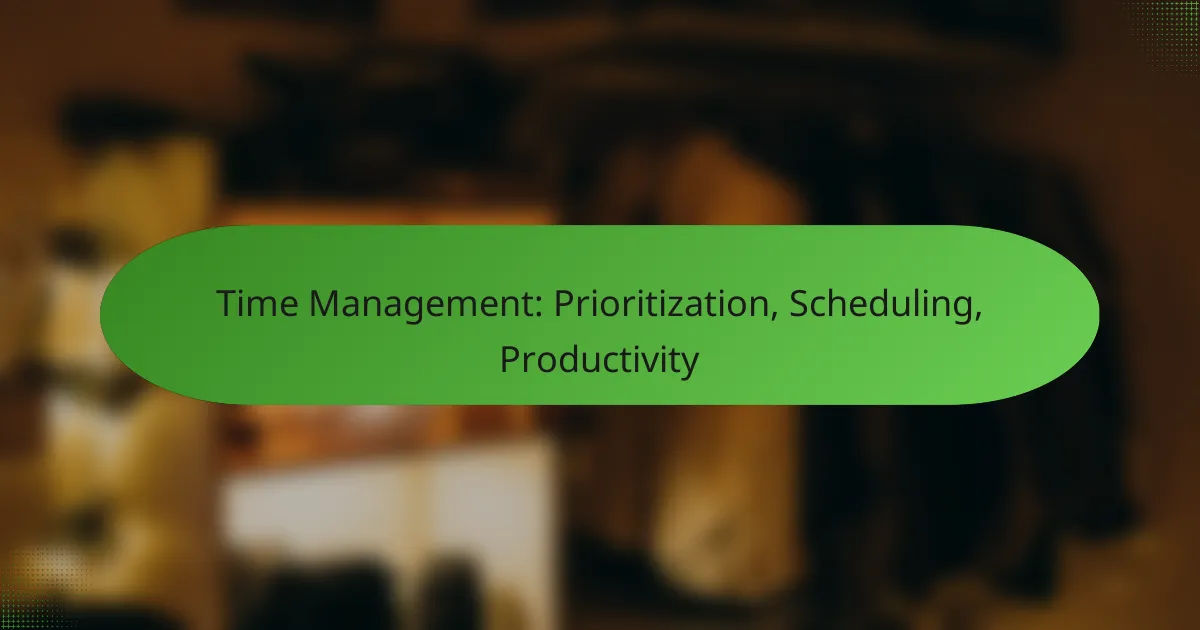Time management is essential for maximizing productivity and achieving your goals. By prioritizing tasks based on their importance and urgency, and employing effective scheduling techniques, you can enhance your focus and efficiency. Utilizing tools like project management software can further streamline your workflow, ensuring you stay on track and accountable.

How to Prioritize Tasks Effectively?
To prioritize tasks effectively, identify what is most important and urgent, then organize your tasks accordingly. This approach helps ensure that you focus on high-impact activities that align with your goals.
Eisenhower Matrix
The Eisenhower Matrix is a simple tool that categorizes tasks into four quadrants based on urgency and importance. Tasks are divided into: urgent and important, important but not urgent, urgent but not important, and neither urgent nor important.
To use this method, list your tasks and place them in the appropriate quadrant. Focus on completing tasks in the first quadrant, delegate those in the third, and consider eliminating those in the fourth. This helps streamline your workload and improve decision-making.
ABC Method
The ABC Method involves assigning a letter to each task based on its priority: ‘A’ for high priority, ‘B’ for medium, and ‘C’ for low. This straightforward classification allows you to focus on the most critical tasks first.
When using this method, review your list regularly and adjust priorities as needed. Aim to complete all ‘A’ tasks before moving on to ‘B’ tasks. This keeps you aligned with your most pressing objectives.
MoSCoW Method
The MoSCoW Method categorizes tasks into four groups: Must have, Should have, Could have, and Won’t have. This technique helps clarify what is essential versus what can be deferred or eliminated.
When applying this method, ensure that ‘Must have’ tasks are prioritized for immediate action. Regularly reassess your ‘Should have’ and ‘Could have’ tasks to adapt to changing circumstances or deadlines.
Value vs. Effort Analysis
Value vs. Effort Analysis helps you evaluate tasks based on their potential impact versus the effort required to complete them. This method encourages you to focus on high-value tasks that require relatively low effort.
Create a simple grid to plot tasks based on their value and effort. Tasks that fall into the high-value, low-effort quadrant should be prioritized, while those in the low-value, high-effort quadrant may be reconsidered or delegated. This analysis promotes efficient use of resources and time.

What Scheduling Techniques Improve Productivity?
Effective scheduling techniques can significantly enhance productivity by helping individuals manage their time more efficiently. Techniques like time blocking, the Pomodoro Technique, and daily and weekly planning provide structured methods to prioritize tasks and maintain focus.
Time Blocking
Time blocking involves dividing your day into distinct blocks dedicated to specific tasks or activities. This method helps eliminate distractions and encourages deep work by allocating uninterrupted time for focused effort. For instance, you might block out 9 AM to 11 AM for project work and 1 PM to 2 PM for meetings.
To implement time blocking, start by identifying your most important tasks and estimating how long each will take. Be realistic with your time estimates and allow for breaks to avoid burnout. A common pitfall is over-scheduling; ensure you leave some flexibility in your blocks for unexpected tasks.
Pomodoro Technique
The Pomodoro Technique is a time management method that uses intervals of focused work followed by short breaks. Typically, you work for 25 minutes, then take a 5-minute break, repeating this cycle to maintain high levels of concentration. After four cycles, a longer break of 15-30 minutes is recommended.
This technique is effective for managing distractions and maintaining motivation. To get started, use a timer to track your intervals and breaks. A common mistake is to skip breaks; however, these pauses are crucial for sustaining productivity over longer periods.
Daily and Weekly Planning
Daily and weekly planning involves setting aside time to outline your tasks and goals for the upcoming days or week. This practice helps prioritize your workload and ensures that you allocate time for both urgent and important activities. A simple approach is to review your tasks every Sunday evening and adjust your daily plans each morning.
When planning, consider using a digital calendar or a planner to visualize your schedule. Be sure to include time for personal activities and self-care to maintain balance. Avoid the trap of overloading your schedule; aim for a realistic number of tasks each day to prevent feeling overwhelmed.

What Tools Enhance Time Management?
Effective time management tools can significantly boost productivity by helping individuals prioritize tasks, schedule activities, and track progress. Popular options include project management software and task organizers that streamline workflows and enhance accountability.
Trello
Trello is a visual project management tool that uses boards, lists, and cards to organize tasks. Users can create boards for different projects and move cards through various stages, making it easy to visualize progress. This setup is particularly useful for teams, as it fosters collaboration and transparency.
To get started, create a board and add lists for different phases of your project, such as “To Do,” “In Progress,” and “Completed.” Then, populate these lists with cards representing individual tasks. Trello’s drag-and-drop interface allows for quick adjustments, but be cautious not to overload boards with too many tasks, which can lead to confusion.
Asana
Asana is a robust task management platform designed for teams to plan, organize, and track work. It offers features like task assignments, due dates, and project timelines, making it easier to manage complex projects. Asana’s flexibility allows for various views, including lists, boards, and calendars, catering to different preferences.
To maximize Asana’s effectiveness, start by creating a project and breaking it down into tasks with clear deadlines. Assign tasks to team members and use tags to categorize them. Regularly review progress during team meetings to ensure alignment and address any roadblocks promptly.
Todoist
Todoist is a simple yet powerful task management app that helps users keep track of personal and professional tasks. It allows for easy categorization through projects and labels, enabling users to prioritize effectively. Todoist’s intuitive interface supports quick task entry and offers reminders to keep deadlines in check.
To use Todoist effectively, create projects for different areas of your life, such as work, home, or personal development. Add tasks with due dates and priority levels to focus on what matters most. Regularly review your tasks and adjust priorities as needed to stay on track and avoid overwhelm.

How to Overcome Procrastination?
To overcome procrastination, it’s essential to identify the reasons behind it and implement effective strategies. By focusing on clear goals, breaking tasks into manageable steps, and involving accountability partners, you can significantly enhance your productivity and motivation.
Setting Clear Goals
Setting clear goals is crucial for overcoming procrastination. Specific and measurable objectives provide direction and motivation, making it easier to take action. For example, instead of saying “I want to exercise more,” a clearer goal would be “I will jog for 30 minutes every Monday, Wednesday, and Friday.”
When establishing goals, consider using the SMART criteria: Specific, Measurable, Achievable, Relevant, and Time-bound. This framework helps ensure that your goals are realistic and attainable, reducing the likelihood of feeling overwhelmed.
Breaking Tasks into Smaller Steps
Breaking tasks into smaller, manageable steps can make daunting projects feel less intimidating. Instead of tackling a large assignment all at once, divide it into smaller tasks with individual deadlines. For instance, if you need to write a report, you might break it down into research, outlining, drafting, and editing.
This approach not only clarifies what needs to be done but also allows for small wins that can boost your motivation. Aim to complete one small step at a time, and celebrate each accomplishment to maintain momentum.
Accountability Partners
Having accountability partners can significantly reduce procrastination by providing external motivation and support. Share your goals with a friend or colleague who can check in on your progress and encourage you to stay on track. This social aspect can make the process more enjoyable and less isolating.
Consider setting regular check-ins, whether weekly or bi-weekly, to discuss your progress and challenges. This not only keeps you accountable but also allows for the exchange of ideas and strategies that can further enhance productivity.

What Are the Benefits of Effective Time Management?
Effective time management leads to numerous advantages, including enhanced productivity and reduced stress levels. By organizing tasks and prioritizing responsibilities, individuals can achieve their goals more efficiently and maintain a healthier work-life balance.
Increased Productivity
Effective time management significantly boosts productivity by allowing individuals to focus on high-priority tasks. When tasks are organized and scheduled, it becomes easier to allocate time appropriately, ensuring that important projects receive the attention they deserve.
To maximize productivity, consider using techniques such as the Eisenhower Matrix, which helps prioritize tasks based on urgency and importance. Additionally, setting specific time blocks for focused work can prevent distractions and enhance output.
Reduced Stress
Managing time effectively can lead to lower stress levels by providing a clear structure for daily activities. When individuals know what they need to accomplish and when, they are less likely to feel overwhelmed by their responsibilities.
To reduce stress, avoid overcommitting by learning to say no to tasks that do not align with your priorities. Regularly reviewing and adjusting your schedule can also help maintain a sense of control and balance, leading to a more relaxed and productive mindset.
